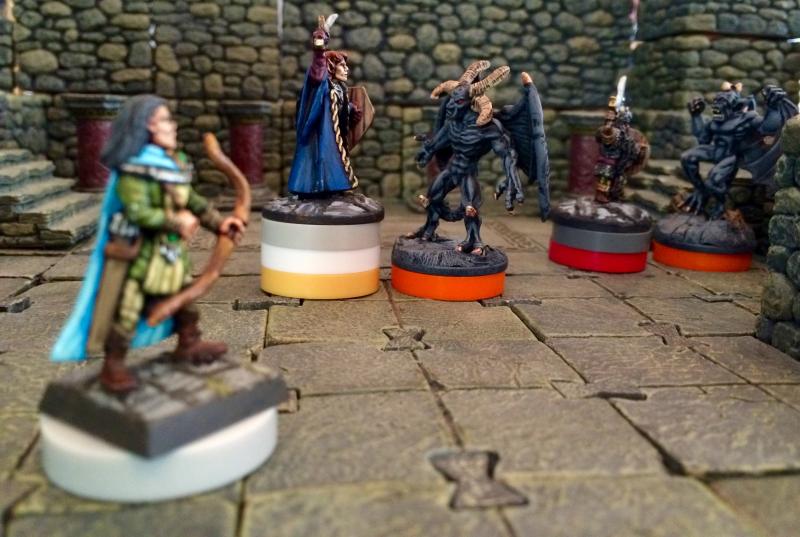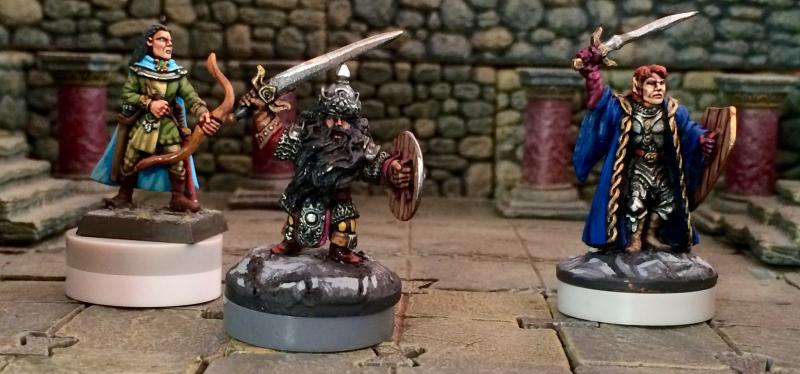Who’s got a light source?” and “Which orc is the most injured?” are seemingly innocent, simple questions that can derail a whole combat. Quick, frenetic battles are the cornerstone of an exciting adventure. Anything that speeds up game play—for me—is a good thing.
A couple years ago, we started Alea tokens in our games and we’ve never looked back. (In fact we use them in every session of my Borderland of Adventure and Shattered Star campaigns). Quick and simple to use they make it easy to get critical information about a character (or monster) by just looking at its base.
We routinely use the tokens to signify two different things—namely, vision and injuries. We do use tokens for other things—poisoned, frightened etc. but the colours for these aren’t set in stone.
Vision
Vision, illumination and light levels are important in a dungeon. Trying to remember who has a torch or whatever is a hassle, but just assuming everyone can see all the time isn’t really very realistic, and can detract from the tension of a battle. Sometimes, battles take place in large rooms and some of the party aren’t aware of (and therefore can’t target) everything lurking in the far shadows. Using three Alea tokens banishes this problem! They are:
- White: A white token means the character is holding (or otherwise using) a light source such as a light spell, torch or sunrod.
- Light Grey: A light grey token means the character has low-light vision.
- Dark Grey: A dark grey token means the character has darkvision.
So, for example, looking at the above picture shows us the elven archer has low-light vision and is carrying a light source (perhaps a light spell cast on his bow), the dwarven fighter has darkvision and the elven swordsman has low-light vision. Neither the dwarven fighter or elven swordsman carry light sources.
Injuries
Sadly, adventurers often get injured and it’s important the group’s healers know who is in dire need of their assistance. The characters’ foes also get injured and often the group’s archers or spell casters want to target the most injured enemy. Alea tokens make it easy for the GM and players to see at a glance who is injured, who is at death’s door and so on.
- No Token: The character is uninjured or has suffered superficial injuries.
- Yellow: The character is lightly wounded and has suffered injuries equal to 25% of its normal hit point total.
- Orange: The character is badly wounded and has suffered injuries equal to 50% of its normal hit point total.
- Red: The character is critically wounded and has suffered injuries equal to 75% of its normal hit point total.
- Black: The character is at death’s door. It is either at 0 hit points or is somehow still active although it has a negative hit point total. (The character could have orc ferocity, the Diehard feat etc.) In any event, the character is probably going to fall over very soon, unless something is done!
Before using Alea tokens, it took ages to ascertain the injured state of everyone in the fight; now we can see at a glance. It takes no time. Take a look at the picture below:
Here we see, things stand on a knife’s edge. While the elven archer remains uninjured, his dwarven companion is critically wounded and his elven friend is badly wounded. Luckily, both gargoyles are also badly wounded. If you were playing a cleric in this fight, you’d know exactly who needs your help most.
Alea Tokens—Not For GMs!
As the GM, I’m a busy chap. I’m listening to the active player, rolling dice and plotting the demise of my hated enemies (the players). I don’t have time to dig out the right Alea token, and apply it to the relevant figure. That’s why one of my players “runs” the Alea tokens. He has the box next to him and adjusts the tokens as necessary. When a character is injured, the player says something like, “Krorz is on black” and the Token Supremo pounces. (I make the same kind of statements for the monsters, unless the PCs would have no way of knowing their wound state—who knows, after all, how injured a gray ooze is after being stabbed/blown up or whacked!)
What Are Alea Tokens?
Alea tokens are small, magnetic tokens sized to fit on a normal 25/28 mm figure’s base. When you buy a set, you also get some adhesive magnetic bases for use with plastic figures, so they can be used with virtually any figure. (You can always balance them on top of a Large or bigger figure’s base.)
Got Other Uses For Alea Tokens?
Do you use Alea tokens? Got any tips I missed here? Let us know in the comments below and help me get run quicker fights.
Finally, a Disclaimer: I’m not affiliated with Alea tokens in any way and I’ve received nothing for this post.


That’s a spiffy system! Now I wish we were using real minis, but instead we’re using Pathfinder Pawns, because they’re such a cheap way of getting monster and NPC tokens. I wonder if I could put a pawn on one of those tokens without it all falling over easily. Hmmm.
Blutack should do the trick!
Do note Alea also sells stickers that make otherwise-not-magnetic minis magnetic to their tokens. Make a pawn army 🙂
http://www.aleatools.com/category-s/23.htm
Thumbs up for this system. My party uses Alea Tools for a very similar wound system. Our approach evolved from a desire to move HP discussion out of the meta-game and into the fiction. The colour coding really does make things easier during the heat of combat.
The sight/light system will definitely be borrowed for our next session.
I’ve been trying to take the HP-talk outno my games too. Between brutally junior players and few long term players, its been a tough habit to break.
I might just have to show them how it’s done as we head into a campaign where I get to play. 🙂
I love my ALEA tools. If I have a group of monsters; say skeletons, I’ll code them with all purple to indicate they are in the same group and then give each one a different color to help delineate which one is being attacked.
ex>
skele one purple and green
skele two purple and blue
skele three purple and red
This looks like a really cool idea. You could also use it to denote a character that is using Fly/Airwalk or maybe other spell effects.
Couldn’t agree more! Alea Tools makes some sweet stuff — I’m an even bigger fan of their numbered glass tokens (pic of my Alea stuff at the link in my name), they’ve streamlined combat quite a bit for us (we’re using GURPS).
Now I’m regretting not buying some at GenCon last year when we had the chance!
After seeing your post on this same topic a while ago, I started using something similar, albeit with some wooden discs and some reusable adhesive.
It’s been working great for vision mechanics. A lot of our sessions have been night/dark encounters so the tokens were immeasurably useful.
The health indicators haven’t been as helpful, as it has felt as though the players were spending more time fiddling with tokens.
But this far, the few dollars I spent along with a fee hours of painting wooden tokens with acrylic paint have been well served.
Epic. I’m glad they’ve helped you game better. Anything that speeds up play is worth it (and you sound much better at DIY/craft than me!)
I was wondering about using coloured correx in place of these discs, maybe made from off-cuts scavenged from a sign shop. Has anyone tried this and how easy is it to punch 1″ discs?
I use cheap poker chips for the same thing. Just sit the minis on top of them to indicate who carrying the light. We also have some tiny magnetic beads for wound markers and spell markers
Love these things but a good kit isn’t cheap.
I’ve used them for well over a decade and they are great! Sometimes the “opposite poles” problem occurs, which can have figures spinning off into the distance, but that’s easily overcome. We tend to use the suggested codes in the box, and use them to show height when flying or levitating, and depth when in water to help with 3-D combat. Other effects include if someone is alight, slowly freezing, melting with acid, affected by glitterdust or faerie fire, and so on. They are good to highlight displacement as well, as they make it clearer why a PC may have missed when you roll suggests they’ve hit. Finally (for the moment) we use them when players THINK something is going on, and they want a warning – “Hey, that kobold breathed fire on me – mark her up with a disk so we know to avoid her!”